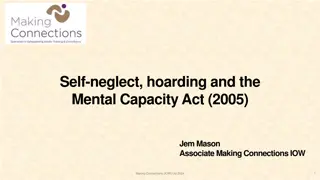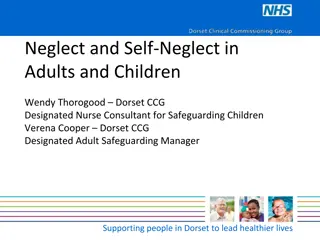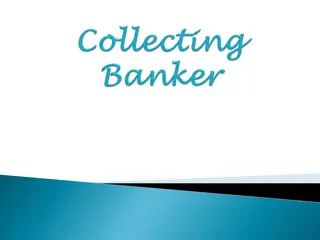
Hoarding vs. Collecting_ Understanding the Difference
Learn the crucial difference between hoarding and collecting, and how to spot the signs of each.n
Download Presentation

Please find below an Image/Link to download the presentation.
The content on the website is provided AS IS for your information and personal use only. It may not be sold, licensed, or shared on other websites without obtaining consent from the author. Download presentation by click this link. If you encounter any issues during the download, it is possible that the publisher has removed the file from their server.
E N D
Presentation Transcript
Hoarding vs. Collecting: Understanding the Difference The distinction between hoarding and collecting might seem subtle at first, but understanding the critical differences can shed light on two entirely separate behaviors. While both involve gathering items, the motivations, organization, and impact on daily life vary drastically. For some, collecting is a source of joy and community, while hoarding can lead to isolation and distress. What Does Collecting Mean? Collecting is an organized, intentional activity centered around acquiring items of personal or monetary value. It is often a passionate pursuit, tied to a theme or specific interest. Examples include rare coins, vintage cars, artwork, or memorabilia. Here s what defines collecting: Purposeful and Organized: Collectors intentionally acquire items and often display them in a way that highlights their value. Enjoyable Hobby: The act of collecting sparks joy and pride, with each addition to the collection bringing satisfaction.
Selective and Focused: A collector is typically discerning, adding only items that fit their theme or goal. No Interference: Collections rarely impede daily functioning and usually complement a person s lifestyle. For collectors, the process is as important as the items themselves. Searching for that elusive piece, visiting trade shows, or connecting with fellow enthusiasts adds to the appeal. What Is Hoarding? Hoarding, by contrast, is a behavior often driven by anxiety, fear, or other emotional challenges. It is recognized as a mental health disorder and differs significantly from collecting in motivation and impact. Characteristics of Hoarding: Difficulty Discarding: Hoarders struggle with letting go of items, regardless of their usefulness or value. Disorganized Spaces: Items pile up chaotically, making living areas cluttered and sometimes unsafe. Emotional Distress: The thought of parting with possessions triggers significant anxiety. No Clear Purpose: Unlike collectors, hoarders lack a theme or strategy behind their accumulation. Hoarding can interfere with daily functioning, relationships, and even physical health, making it a behavior that often requires professional intervention. Comparing Hoarding and Collecting 1. Organization and Display Collectors: Items are neatly displayed, often in showcases or specific areas designated for the collection. Hoarders: Living spaces become cluttered, with piles of items impeding daily activities.
2. Emotional Connection Collectors: Emotional ties stem from interest and enjoyment. Hoarders: Attachments often stem from fear, anxiety, or a sense of security tied to the items. 3. Impact on Life Collectors: Collections enrich the collector s life, providing a sense of achievement. Hoarders: Hoarding creates stress, impairs relationships, and can lead to isolation. 4. Ability to Let Go Collectors: Can part with items if necessary, especially duplicates or less significant pieces. Hoarders: Experience intense distress at the thought of discarding items. 5. Health and Safety Risks Collectors: Collections are maintained in a way that poses no risk. Hoarders: Clutter can create hazards like fire risks or hygiene issues. Why Understanding the Difference Matters Recognizing the difference between hoarding and collecting is essential, especially when a behavior starts to negatively affect someone s life. For example, while collectors can maintain balance, hoarders may find their environments becoming unmanageable, affecting their mental health and relationships. This distinction also helps friends and family provide the right kind of support. A person with hoarding tendencies might need professional Hoarding Help, while a collector might simply benefit from encouragement and shared enthusiasm. The Role of Hoarding Help For transformative. Decluttering services for hoarders often involve therapy, particularly individuals struggling with hoarding, professional intervention can be
cognitive-behavioral psychological challenges. therapy (CBT), to address the underlying emotional and Therapy for hoarding typically includes: Understanding Emotional Triggers: Identifying why certain items hold such significant emotional weight. Building Organizational Skills: Teaching practical methods for sorting and decluttering. Creating Healthy Habits: Developing strategies to prevent future hoarding tendencies. Seeking Help is not just about clearing clutter; it s about improving mental health and reclaiming a safe, functional living environment. Collecting as a Social and Positive Pursuit Collecting often fosters connections and provides a sense of accomplishment. Many collectors join groups or communities where they share knowledge, trade items, or celebrate their shared passions. This social aspect can be incredibly fulfilling, offering collectors a sense of belonging. Additionally, collecting enhances a person's knowledge and skills. For example, a coin collector might become an expert in historical currencies, while a book collector might develop an appreciation for rare manuscripts. When Hoarding Becomes a Problem Hoarding becomes an issue when it interferes with daily life. Signs that someone may need intervention include: Rooms that are too cluttered to use for their intended purpose. Persistent distress or anxiety about discarding items. Strained relationships due to arguments about clutter. Financial or legal trouble caused by excessive acquisition or neglect. Practical Steps for Managing Clutter Tips for Collectors
1. Define a Space: Allocate specific areas for your collection to avoid encroaching on living spaces. 2. Focus on Quality Over Quantity: Prioritize items that add value or significance to your collection. 3. Review Regularly: Periodically assess your collection and remove items that no longer fit your theme. Tips for Hoarders 1. Start Small: Begin decluttering with a single category, like old magazines or clothing. 2. Ask for Help: Involve trusted friends, family, or professionals in the process. 3. Set Realistic Goals: Break the decluttering process into manageable steps. Table: Hoarding vs. Collecting Aspect Collecting Hoarding Organization Systematic and purposeful Disorganized and chaotic Emotional Attachment Tied to interest and enjoyment Tied to anxiety and fear Impact on Life Positive or neutral Negative, often severe Discarding Ability Possible when necessary Extremely difficult Health/Safety Rarely an issue Often a significant concern Conclusion Hoarding and collecting may appear similar at a glance, but their differences are profound. Collecting is a structured, enjoyable activity that enriches lives, while hoarding is a mental health condition that can disrupt daily life and relationships. Recognizing these distinctions is crucial for offering appropriate Hoarding Help when needed or fostering healthy collecting habits. Site Article: Hoarding vs. Collecting: Understanding the Difference






















